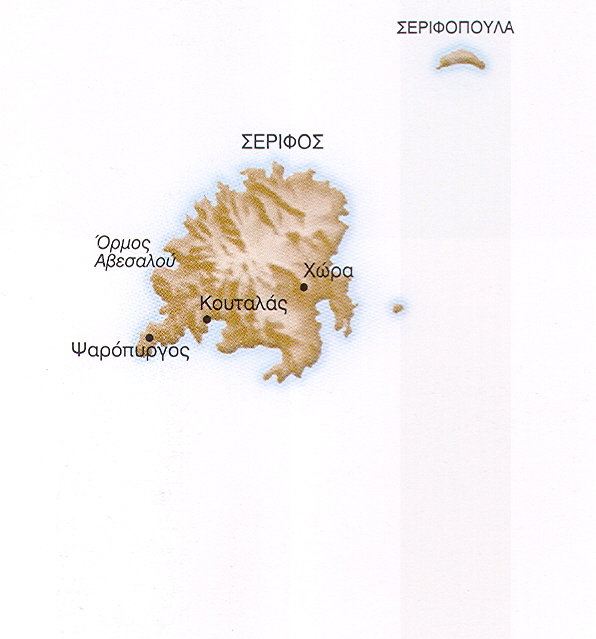SERIPHOS
The “rough and stony" Seriphos of the ancient lexicographers is still largely unexplored. The island was known in Antiquity for its iron and copper mines. Indeed, it has been suggested that its name derives etymologicaily from the Phoenician route sareph, which means foundry. Mining and metallurgical activities date back to the Early Cycladic period (3rd millennium Be). Mining installations have been identified on the Kephala Peninsula, while considerable deposits of scoriae can be seen in the wider are oi Avesalos Bay.
Apollodorus (I 88.2, II 36.1 ff.) mentions that the first settlers on the island were Polydektes and Diktys, Aeolians from Thessaly. According to Herodotus (VIII 48.4-3), Seriphos was colonized later by Ionians from Athens.
The ancient city probably occupied the same site as the present Chora (fig. 360), which is why archaeological evidence is scant. A few remains of the fortification of the acropolis survive, as well as dispersed antiquities, among them an inscription recording that the agora was repaired in Roman times, and other inscriptions referring to the balneum (public bathhouse) and the peripaios (circuit walkway). The city’s outport was presumably the sheltered bay at Livadi.
The best-preserved towers are on the west side of the island. Outstanding are the marble round tower known as Aspros Pyrgos, in Koutalas Bay, the rectangular Psaropyrgos (or Kanapes tou Kyklopa) on the Kyklopas headland southwest of Megalo Livadi, and a round tower constructed of marble and gneiss, on the col of the Kephala Peninsula. Some of these towers appear to have been associated with mining and metallurgical activities.
According to Pausanias (I 22,7 and II 18,1), one of the Seriphians' foremost cults was of Perseus. 1 he earliest coins of the island are silver staters, dating from the sixth century BC, the obverse of which features the “Seriphian frog", who is linked with the local cult of Perseus, and the reverse the incuse square. Represented on bronze issues of the Hellenistic period are Perseus on the obverse and Medusa or the harpe, the scythe with which the hero beheaded the Gorgon, on the reverse.
There is a small archaeological collection in Chora, where fortuitous finds from all over the island are gathered.
Original text from Mazarakis Ainian, A. 2006. Seriphos, Vlachopoulos, A. G. (ed.) Archaeology: Aegean Islands, Αthens, 250-251.
BIBLIOGRAPHY
Dill, H. G., W. Bäumler & A. Techmer. 2008. Early Bronze Age Mining Activities on the Island of Seriphos, Greece, Mediterranean archaeology, 21: 1-2.
Euangelidēs, T. E. 1909. Η νήσος Σέριφος και αι περί αυτήν νησίδες : μελέτη τοπογραφικο-ιστορική μετά χάρτου της Νήσου και εικόνων, Ερμουπόλει.
Georgakopoulou, M. & I. Basiakos. 2011. Seriphos Surfaces : a Study of Copper Slag Heaps and Copper Sources in the Context of Early Bronze Age Aegean Metal Production, Archaeometry 53: 123-145.
Gerola, G. 1921. Sèrfino (Sèriphos), ASAA III (1916-1920): 203-241.
Mazarakis Ainian, A. 2006. Seriphos, Vlachopoulos, A. G. (ed.) Archaeology: Aegean Islands, Αthens, 250-251.


